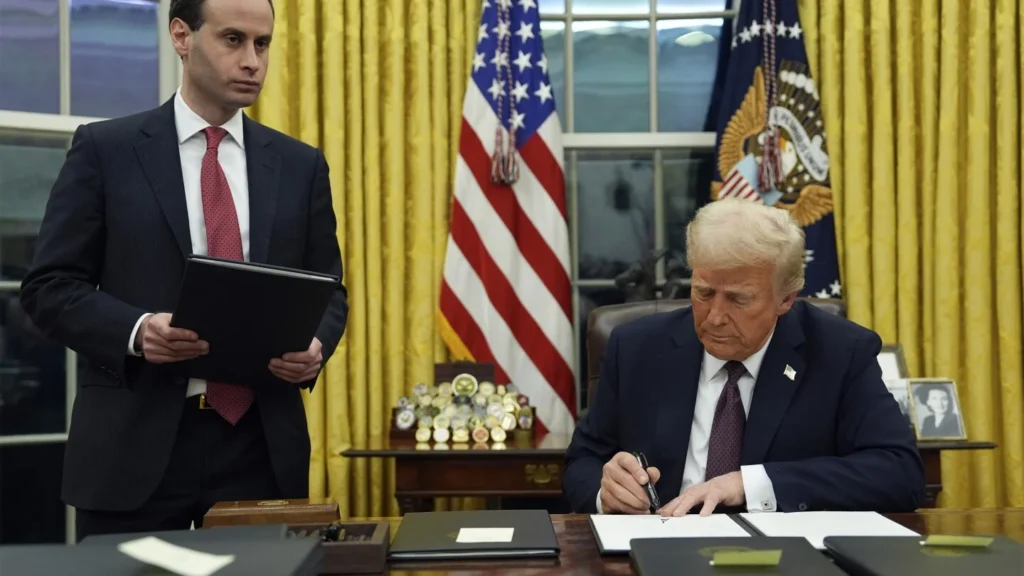Key Takeaways
- The Trump administration is pushing to roll back federal regulations across agencies, known as the ‘Trump deregulation agenda.
- Led by the Department of Government Efficiency (DOGE), the strategy involves rapid repeal or non-enforcement of rules, leveraging recent Supreme Court decisions.
- Industries stand to benefit, but critics warn of risks to public safety, health, and environmental protections.
- The approach bypasses traditional lengthy legal processes, raising concerns about legal challenges and long-term impacts.
Trump’s Deregulation Agenda: Introduction
Imagine a world where the rules governing everything from clean water to workplace safety are suddenly rewritten—or erased entirely. That’s the vision driving the Trump administration’s latest push for deregulation. With a mission to shrink the federal government’s footprint, officials are targeting regulations they see as burdensome, arguing they stifle innovation and economic growth. But what does this mean for everyday Americans? Let’s dive into the heart of this sweeping campaign, exploring its goals, methods, and potential consequences.
What Is Trump’s Deregulation Agenda?
At its core, the Trump administration’s deregulation agenda is about rolling back federal rules that govern industries, public health, and safety. From the Environmental Protection Agency (EPA) to the Department of Agriculture, agencies are compiling lists of regulations to eliminate or stop enforcing. The Department of Government Efficiency (DOGE), under the direction of Russell T. Vought and directed by Elon Musk, is leading the initiative, which attempts to increase business efficiency and streamline government operations.
This isn’t a new idea—Republican administrations have long championed deregulation. But what sets this agenda apart is its speed and scope. Unlike the slow, methodical process of past rollbacks, Trump’s team is moving fast, leveraging legal loopholes and recent court rulings to act decisively. The goal? A leaner government that, in their view, empowers businesses and frees up the economy.
Why Deregulation Matters
Regulations are like the guardrails of society—they keep planes flying safely, food free of contaminants, and workers protected from harm. But they can also be complex and costly for businesses to comply with. The Trump administration argues that many rules are outdated or overly restrictive, slowing down progress. For example, some regulations still require companies to submit reports via telegram—a method as outdated as a rotary phone.
On the flip side, critics argue that slashing these rules could unravel decades of progress. Think about it: without strict oversight, could you trust the water you drink or the meat you eat? It’s a high-stakes debate, and the outcome will shape American life for years to come.
The Mechanics of Mass Deregulation
So, how does the administration plan to pull this off? It’s more complicated than just pressing the delete button. Federal regulations are typically hard to undo—by design. The Administrative Procedure Act of 1946 requires public comment periods and lengthy reviews before rules can be changed. But Trump’s team has a different playbook.
Bypassing the Process
One bold move is skipping the usual public comment period for many rule changes. A recent White House directive instructed agencies to repeal certain regulations immediately, sidestepping a process that can take years. This approach, while efficient, is likely to spark legal challenges. Experts like Susan Dudley, a former regulatory official, warn that such shortcuts could be struck down in court.
Leveraging Supreme Court Rulings
The administration is also banking on recent Supreme Court decisions to justify its actions. Two key rulings—one in 2022 limiting the EPA’s authority over carbon emissions and another in 2024 ending Chevron deference—have weakened agencies’ regulatory powers. These decisions give Trump’s team legal ammunition to argue that many existing rules are now vulnerable.
Additionally, an obscure 1985 ruling, Heckler v. Chaney, allows agencies to stop enforcing regulations without immediate court oversight. This strategy—essentially ignoring rules while working to repeal them—could have immediate effects, according to legal scholar Lisa Heinzerling. It’s a clever, if controversial, way to fast-track deregulation.
The Role of DOGE

The Department of Government Efficiency, or DOGE, is the engine behind this effort. Co-founded by Elon Musk and initially shaped by Vivek Ramaswamy, DOGE is tasked with cutting government waste and slashing regulations. Musk has even developed an AI tool to scan the 100,000-plus pages of the Code of Federal Regulations, hunting for outdated or legally shaky rules. While it’s unclear how effective this tool is, the ambition is clear: a top-to-bottom overhaul of the regulatory system.
Industry’s Golden Opportunity
For businesses, this is like Christmas morning. Industries from manufacturing to energy have long lobbied for lighter regulations, and now they have allies across the administration. Agency heads, many with deep industry ties, are eager to rewrite rules that affect their sectors.
Take the U.S. Chamber of Commerce, for example. Marty Durbin, a senior vice president, calls this a chance to “rebalance the regulatory environment.” Groups like the American Petroleum Institute and the National Association of Manufacturers have submitted wish lists of rules they want gone, particularly those governing labor and environmental protections.
Case Studies: What’s on the Chopping Block?
Let’s zoom in on a few examples to see what’s at stake:
- EPA’s Climate Rules: Administrator Lee Zeldin has targeted 31 regulations, including limits on auto emissions and chemical pollution. These rules, designed to combat climate change and protect public health, are seen by critics as critical to a sustainable future.
- Agriculture Department’s Food Safety: Secretary Brooke Rollins wants to speed up pork and poultry processing lines, replacing some government inspectors with corporate ones. Supporters say this cuts red tape; opponents, like union leader Mark Lauritsen, warn it could lead to contaminated meat and unsafe working conditions.
- Health and Human Services: Officials are eyeing a rule requiring more medical staff in nursing homes, arguing it’s too costly. But reducing staff could compromise care for vulnerable residents.
These examples highlight the tension: efficiency versus safety, profit versus protection.
The Risks of Rapid Deregulation
Not everyone’s cheering. Critics argue that dismantling regulations could jeopardize public safety and health. Steve Cicala, an economist with the National Bureau of Economic Research, points out that regulations underpin America’s high quality of life. From safe drinking water to crash-resistant cars, these rules save lives.

Real-World Impacts
Consider the Mine Safety and Health Administration, where lobbying groups want to scrap a rule protecting miners from crystalline silica dust—a known lung hazard. Without this protection, miners could face higher risks of deadly diseases like silicosis. Similarly, loosening food safety inspections could lead to outbreaks of illness, as seen in past contamination scandals.
Then there’s the environment. Rolling back EPA rules could weaken efforts to curb pollution and combat climate change. For communities near industrial sites, this could mean dirtier air and water. It’s a gamble, and the stakes are high.
Legal and Long-Term Challenges
The administration’s aggressive tactics may backfire. Legal experts predict a flood of lawsuits challenging the rapid repeal of rules. Courts could block or delay changes, especially if agencies skip required processes. And what happens when a new administration takes over? Rules erased today could be reinstated tomorrow, creating a regulatory rollercoaster.
A Balancing Act: Efficiency vs. Safety
So, where’s the middle ground? Deregulation isn’t inherently bad—some rules are outdated or redundant. Kent Lassman of the Competitive Enterprise Institute compares the regulatory system to “sedimentary rock,” built up over decades and in need of a trim. But slashing too much, too fast, could destabilize systems that protect millions.
The administration’s supporters argue they’re cutting fat, not muscle. Harrison Fields, a White House spokesman, says lessons from Trump’s first term have sharpened their approach. They’re not just swinging blindly—they’re targeting rules they believe hold back progress.
Still, the question remains: Can you streamline government without sacrificing safety? It’s like trying to renovate a house while people are still living in it—one wrong move, and the whole structure could weaken.
Voices from the Ground
To understand the human side, let’s hear from those affected. Workers like those represented by the United Food and Commercial Workers Union worry about faster production lines leading to injuries or tainted food. Families in nursing homes fear fewer staff could mean neglected loved ones. And environmental activists are sounding alarms about weakened climate protections.
Conversely, small business owners applaud the prospect of reduced bureaucracy. For them, navigating complex regulations can feel like wading through molasses. A simpler system could mean more time and money to grow their companies.
Conclusion
Trump’s deregulation strategy is a risky, audacious, and high-wire act. It promises to reshape the American economy, freeing businesses from what some call government overreach. But it also threatens to unravel safeguards that protect health, safety, and the environment. As agencies race to meet deadlines and courts brace for challenges, the nation watches a historic experiment unfold. Will this be a triumph of efficiency or a cautionary tale of haste? Only time will tell.


